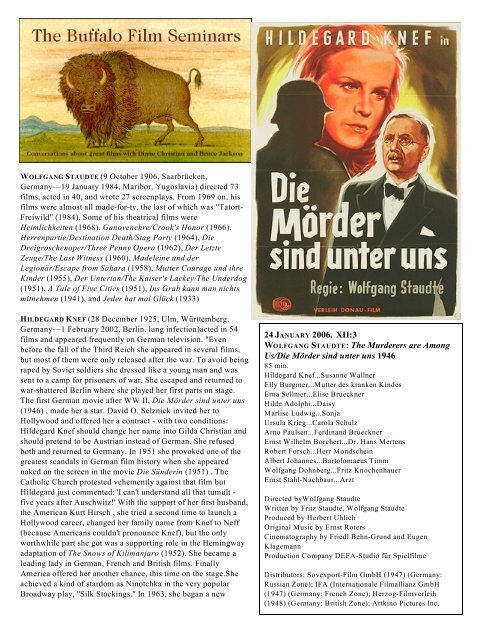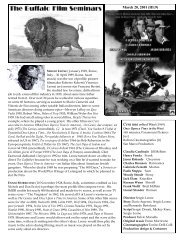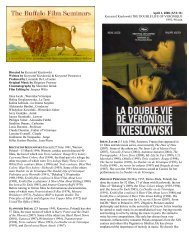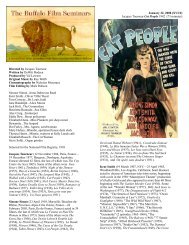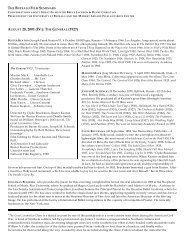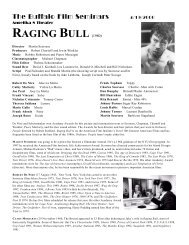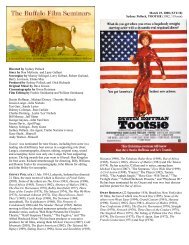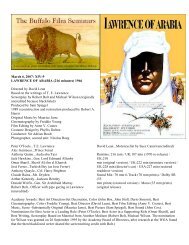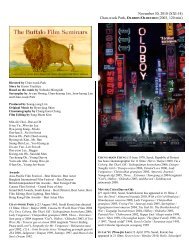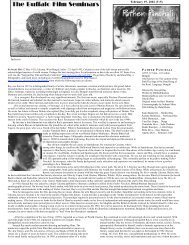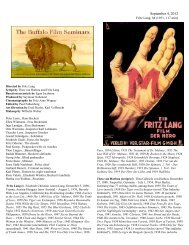24 JANUARY 2006, XII:3 WOLFGANG STAUDTE - Center for ...
24 JANUARY 2006, XII:3 WOLFGANG STAUDTE - Center for ...
24 JANUARY 2006, XII:3 WOLFGANG STAUDTE - Center for ...
Create successful ePaper yourself
Turn your PDF publications into a flip-book with our unique Google optimized e-Paper software.
<strong>WOLFGANG</strong> <strong>STAUDTE</strong> (9 October 1906, Saarbrücken,<br />
Germany—19 January 1984, Maribor, Yugoslavia) directed 73<br />
films, acted in 40, and wrote 27 screenplays. From 1969 on, his<br />
films were almost all made-<strong>for</strong>-tv, the last of which was "Tatort-<br />
Freiwild" (1984). Some of his theatrical films were<br />
Heimlichkeiten (1968), Ganovenehre/Crook's Honor (1966),<br />
Herrenpartie/Destination Death/Stag Party (1964), Die<br />
Dreigroschenoper/Three Penny Opera (1962), Der Letzte<br />
Zeuge/The Last Witness (1960), Madeleine und der<br />
Legionär/Escape from Sahara (1958), Mutter Courage und ihre<br />
Kinder (1955), Der Untertan/The Kaiser's Lackey/The Underdog<br />
(1951), A Tale of Five Cities (1951), Ins Grab kann man nichts<br />
mitnehmen (1941), and Jeder hat mal Glück (1933)<br />
HILDEGARD KNEF (28 December 1925, Ulm, Württemberg,<br />
Germany—1 February 2002, Berlin, lung infection)acted in 54<br />
films and appeared frequently on German television. "Even<br />
be<strong>for</strong>e the fall of the Third Reich she appeared in several films,<br />
but most of them were only released after the war. To avoid being<br />
raped by Soviet soldiers she dressed like a young man and was<br />
sent to a camp <strong>for</strong> prisoners of war. She escaped and returned to<br />
war-shattered Berlin where she played her first parts on stage.<br />
The first German movie after WW II, Die Mörder sind unter uns<br />
(1946) , made her a star. David O. Selznick invited her to<br />
Hollywood and offered her a contract - with two conditions:<br />
Hildegard Knef should change her name into Gilda Christian and<br />
should pretend to be Austrian instead of German. She refused<br />
both and returned to Germany. In 1951 she provoked one of the<br />
greatest scandals in German film history when she appeared<br />
naked on the screen in the movie Die Sünderin (1951) . The<br />
Catholic Church protested vehemently against that film but<br />
Hildegard just commented: 'I can't understand all that tumult -<br />
five years after Auschwitz!' With the support of her first husband,<br />
the American Kurt Hirsch , she tried a second time to launch a<br />
Hollywood career, changed her family name from Knef to Neff<br />
(because Americans couldn't pronounce Knef), but the only<br />
worthwhile part she got was a supporting role in the Hemingway<br />
adaptation of The Snows of Kilimanjaro (1952). She became a<br />
leading lady in German, French and British films. Finally<br />
America offered her another chance, this time on the stage.She<br />
achieved a kind of stardom as Ninotchka in the very popular<br />
Broadway play, "Silk Stockings." In 1963, she began a new<br />
<strong>24</strong> <strong>JANUARY</strong> <strong>2006</strong>, <strong>XII</strong>:3<br />
<strong>WOLFGANG</strong> <strong>STAUDTE</strong>: The Murderers are Among<br />
Us/Die Mörder sind unter uns 1946<br />
85 min.<br />
Hildegard Knef...Susanne Wallner<br />
Elly Burgmer...Mutter des kranken Kindes<br />
Erna Sellmer...Elise Brueckner<br />
Hilde Adolphi...Daisy<br />
Marlise Ludwig...Sonja<br />
Ursula Krieg...Carola Schulz<br />
Arno Paulsen...Ferdinand Brueckner<br />
Ernst Wilhelm Borchert...Dr. Hans Mertens<br />
Robert Forsch...Herr Mondschein<br />
Albert Johannes...Bartolomaeus Timm<br />
Wolfgang Dohnberg...Fritz Knochenhauer<br />
Ernst Stahl-Nachbaur...Arzt<br />
Directed byWolfgang Staudte<br />
Written by Fritz Staudte, Wolfgang Staudte<br />
Produced by Herbert Uhlich<br />
Original Music by Ernst Roters<br />
Cinematography by Friedl Behn-Grund and Eugen<br />
Klagemann<br />
Production Company DEFA-Studio für Spielfilme<br />
Distributors: Sovexport-Film GmbH (1947) (Germany:<br />
Russian Zone); IFA (Internationale Filmallianz GmbH<br />
(1947) (Germany: French Zone); Herzog-Filmverleih<br />
(1948) (Germany: British Zone); Artkino Pictures Inc.
career as a singer and surprised the audience with her typical, deep, smoky voice and the fact that many lyrics of her songs<br />
were written by herself. In 1970, she wrote the autobiographical bestseller Der Geschenkte Gaul. She got sympathy from all<br />
over the world <strong>for</strong> her fight against cancer, which she defeated several times. After the German reunification, she moved back<br />
to Berlin." (IMDB.com)<br />
Wolfgang Staudte, from World Film Directors Vol I. Ed.<br />
John Wakeman. The H. W. Wilson Company, NY, 1987.<br />
German director, scenarist, and actor, was born in<br />
Saarbrücken, the son of Fritz Staudte and the <strong>for</strong>mer Matilde<br />
Firmans. Both parents were actors and their careers took them<br />
in 1912 to Berlin, where Wolfgang Staudte grew up. His first<br />
interest was not show business but engineering, and he began<br />
studies in the subject at Oldenburg. He disliked theoretical<br />
work, however, and after two years took up apprenticeship,<br />
first with Mercedes in Berlin, then with Hansa-Werken in<br />
Varel.<br />
Staudte’s mother died when he was fifteen, but Fritz<br />
Staudte had become well-known as an actor at Berlin’s leftwing<br />
“people’s theatre,” the Volksbühne. Having made up his<br />
mind to resume his engineering studies, Wolfgang Staudte<br />
first visited his father at the Volksbühne—then under the<br />
direction of Erwin Piscator—and was immediately fascinated<br />
by what he saw. Instead of returning to Oldenburg he went off<br />
to a theatrical agency and was soon hired by a manager who<br />
apparently mistook him <strong>for</strong> his father. Staudte survived his<br />
debut at a theatre in Schneidemül, but flopped in a second<br />
play, and was fired.<br />
In 1926, returning to Berlin, Staudte joined his father<br />
at the Volksbühne , appearing during the next few years in<br />
productions directed by Piscator and Max Reinhardt, among<br />
others. Beginning in 1931, he also secured his first small<br />
movie roles. During this period his father, a committed<br />
socialist, founded his own politically oriented theatre<br />
company. Staudte appeared in two of his father’s productions<br />
and through him had contact with radical circles in Berlin.<br />
Though sympathetic to his father’s views Staudte did not<br />
really regard himself as a radical artist. Nevertheless, these<br />
contacts, and his involvement with the Volksbühne, were<br />
enough to cost him an actor’s permit when Hitler came to<br />
power in 1933.<br />
For the next two years Staudte earned his living<br />
dubbing <strong>for</strong>eign films <strong>for</strong> the Rythmoton Company. By 1935<br />
the situation had eased a little; he was able to get a radio job<br />
reading children’s stories and commercials, and the same<br />
year he entered the film business, making advertisements to<br />
be shown in movie theatres. Staudte is said to have directed<br />
and edited (and often scripted as well) about a hundred of<br />
these commercials, each between 80 and 130 seconds long, in<br />
this way mastering the rudiments of his craft and in particular<br />
learning how to present the essentials of what he had to say<br />
with maximum economy and clarity. He was also able to<br />
resume his work as a bit-player in films by other directors,<br />
including Veit Harlan’s Jud Süss (1940). (It should be said<br />
that, according to Harlan himself, “virtually every actor” in<br />
this disgusting work of anti-Semitic propaganda was<br />
“per<strong>for</strong>ming under duress.”)<br />
Staudte’s experience as a director of commercials<br />
finally brought him<br />
an invitation from<br />
the Tobis<br />
production<br />
company to make<br />
his first fiction<br />
film. This was a<br />
satirical short<br />
called Ins Grab<br />
kann nichts<br />
mitnehmen (You<br />
Can’t Take It With You, 1941). Other shorts followed, and in<br />
1942, when Tobis hired the circus clown Charlie Rivel and<br />
needed a vehicle <strong>for</strong> him, Staudte submitted a synopsis and<br />
was assigned to direct his first feature.<br />
...Staudte went on to make four more films <strong>for</strong> Tobis,<br />
which by that time was wholly under government control. A<br />
romance called Ich hab’ von Dir geträumt (I Dreamed of<br />
You, 1944) was followed in 1944-1945 by Der Mann, dem<br />
Man den Namen stahl (The Man Whose Name Was Stoken).<br />
A satire on bureaucracy, it was banned by Goebbel’s<br />
propaganda ministry, which reportedly wanted Staudte sent<br />
to the front by way of punishment. Thanks to the intervention<br />
of the actor Heinrich George, Staudte was given another<br />
chance and made Frau über Bord (Woman Overboard), also<br />
known as Kabine 27. He finished shooting this film be<strong>for</strong>e<br />
the end of the war but apparently never completed the<br />
editing.<br />
After the war, film production in Germany resumed<br />
in the various zones. In the zones occupied by the Unites<br />
States, Britain, and France, licenses were issued to individual<br />
production units, while in the East the Soviet Union<br />
established DEFA, a state-owned monopoly based on the old<br />
UFA studios. Though Staudte lived in the West, he first<br />
worked <strong>for</strong> DEFA, writing and directing its first postwar<br />
feature, Die Mörder sind unter Uns (Murderers Among Us,<br />
1946).<br />
Like a number of subsequent East German films, it is<br />
a study in war guilt. A <strong>for</strong>mer army doctor (Ernst Fischer) is<br />
wracked by agonizing memories of a civilian massacre in<br />
Poland. He has become a self-pitying alcoholic, haunting the<br />
ruins of Berlin obsessed by the desire to murder the officer<br />
who had ordered the massacre, now a prosperous<br />
businessman with a devoted family. The doctor’s sanity and<br />
self-respect is restored by Susanne, who has survived years in<br />
a concentration camp determined to make sense of her life<br />
and the lives around her, and who is still capable of love.<br />
Manvell and Fraenkel write in The German Cinema<br />
that the film “was remarkable not only <strong>for</strong> its subject, a<br />
significant one <strong>for</strong> the period, but also <strong>for</strong> its use of the ruins<br />
of Berlin, its sparse music score by Ernst Rotors, and perhaps<br />
above all <strong>for</strong> the per<strong>for</strong>mance of a young actress new to the
screen, Hildegard Knef, who played Suzanne. The film is full<br />
of imaginatively visualized moments, created out of a deep<br />
experience which the filmmaker shares with his characters.<br />
At the opening, a piano plays light jazz as the camera covers<br />
the ruins of Berlin, the crowded dance-halls, the overladen<br />
trains, the derelict railway station. Gradually the girl is<br />
singled out of the crowd until she is in close-shot; she is<br />
absorbing the pure pleasure of her freedom, her eyes full of<br />
tears. The doctor, finally seen in a haze of tobacco smoke<br />
poring in a drunken trance over a chessboard, has also been<br />
first glimpsed in the crowded streets. Suddenly the words<br />
‘mass grave’ are followed by a spinning shot of the legs of<br />
ballet dancers and then a scene of rain-drenched streets. The<br />
ruins themselves are the recurrent motif of the film; in some<br />
shots the rubble seems like a landscape from the moon.”<br />
The success of Murderers Among Us encouraged<br />
others to produce what became known as Trümmerfilme<br />
(“rubble films"). These portrayals of the physical and<br />
psychological wreckage of postwar Germany, resigned and<br />
often self-pitying in tone, were shot on location rather than in<br />
the studio and seemed to some critics to promise a German<br />
realist movement comparable to Italian neo-realism, though<br />
without the latter’s use of nonprofessional actors. No such<br />
development in fact occurred, and Staudte’s own next DEFA<br />
film was Die selftsamen Abenteuer des Herrn Fridolin B.<br />
(1948), a much-revised version of Der Mann, dem Mann den<br />
Namen stahl, the satire on bureaucracy banned by the Nazis.<br />
In 1948 Staudte directed the German episode in the<br />
international coproduction released four years later as<br />
Geschichte von fünf Städten (A Tale of Five Women/ a Tale of<br />
Five Cities). Staudte wrote or coauthored most of his films,<br />
and in the case of his next film Rotation (1949), conceived<br />
the original ideas as well. It tells the story of an ordinary<br />
German worker from the late 1920s to 1945. Hans Behnke<br />
(Paul Esser) reluctantly joins the Nazi party during the<br />
depression because he will lose his job if he does not. It<br />
seems an understandable decision, but the rest of the film<br />
illustrates the appalling costs of such a compromise, and<br />
makes clear that Behnke’s son—and all of us—face equally<br />
crucial choices.<br />
Rotation was generally admired as “a powerful<br />
technical and artistic per<strong>for</strong>mance,” and there was high praise<br />
<strong>for</strong> Der Untertan (The Underdog, 1951). Based on a novel by<br />
Heinrich Mann, and set in Germany at the turn of the century,<br />
it shows how a timid and obsequious boy, through blind<br />
loyalty to the social hierarchy, rises to a position of great<br />
power and authority. Some critics found it turgid and clumsy<br />
in its didacticism, but many others did not. The French<br />
director Chris Marker wrote that “one is presented, with a<br />
power and cruelty which recall von Stroheim, with German<br />
society as it was at the end of the Empire....But the most<br />
interesting part of the story is the furore which the film has<br />
caused in West Germany; because old pre-1914 Germany had<br />
disconcerting similarities, on essential points, with that which<br />
is reviving under Adenauer.”<br />
Another notable film of the period, also made <strong>for</strong><br />
DEFA, was Die Geschicte des kleinen Muck (Little Muck,<br />
1953), a children’s film in Agfacolor about an unloved<br />
hunchback boy who achieves influence at the Sultan’s<br />
decadent court and uses it <strong>for</strong> the good of the people. Ciske<br />
de Rat (1955), dealing with the rehabilitation of a boy who<br />
accidentally kills his mother, was based on a Dutch bestseller<br />
and made in the Netherlands. It won the Silver Lion at<br />
Venice. Work then began on a DEFA adaptation of Brecht’s<br />
Mutter Courage, but this project fell through and the film<br />
was later completed by Peter Palitzsch and Manfred<br />
Wekwerth.<br />
By this time, according to Manvell and Fraenkel,<br />
“Staudte was becoming restive under the increasing controls<br />
in East Germany and, without actually breaking with DEFA,<br />
began to direct films in West Germany,” The first of these<br />
was Rose Bernd (The Sins of Rose Bernd, 1956), starring<br />
Maria Schell and derived from Hauptmann’s grimly<br />
naturalistic drama about an unmarried mother driven by a<br />
heartless society to murder her baby. Madeleine und der<br />
Legionär (1957), with Hildegard Knef having to choose<br />
between love and patriotism, was followed by Kanonen-<br />
Serenade (Always Victorious/Il Capitano, 1958), a West-<br />
German-Italian co-production in which Vittorio De Sica<br />
plays the captain of a banana boat who is dragged reluctantly<br />
into wartime politics.<br />
After Der Maulkorb (1958)m another literary<br />
adaptation—this time from a novel by Heinrich<br />
Spoerl—came one of the most notable of Staudte’s West<br />
German films, Rosen für den Staatsanwalt (Roses <strong>for</strong> the<br />
Prosecutor, 1959). In the chaos of Hitler’s last days, an SS<br />
prosecutor (Martin Held) condemns a feckless soldier to<br />
death <strong>for</strong> a trivial crime. The soldier escapes to become an<br />
equally feckless peddler. Some years after the war, he runs<br />
afoul of the laws of a theoretically different regime, but is<br />
confronted in court by the same Himmler-like prosecutor<br />
(who finds the encounter considerably more embarrassing<br />
than he does). Dilys Powell called it a “satire with...political<br />
teeth” that is “directed and played with a kind of wry<br />
grace,,,,Suddenly one thinks hopefully of the prospect of a<br />
reviving German cinema.” This ironic and intelligent film<br />
took the first prize at Karlovy Vary as well as a West German<br />
award.<br />
The return of <strong>for</strong>mer Nazis to positions of power in<br />
West Germany is also the theme of Kirmes (Fairground,<br />
1960). The erection of a carousel in a small town involves the<br />
excavations which reveal the body of a wartime deserter. It<br />
emerges that he had been hounded to his death by an SS<br />
official—a man who has since become the town’s mayor....<br />
In 1963 Staudte made a new version of Die<br />
Dreigroschenoper (The Threepenny Opera, 1963), starring<br />
Curt Jürgens, Hildegard Knef, and Gert Fröbe....None of<br />
Staudte’s later movies had added much to his reputation and,<br />
beginning in the late 1960s, he concentrated mainly on<br />
television, directing numerous episodes of Der Kommisar,<br />
Der Seewolf and other series, as well as individual television<br />
films, until his death in 1984.<br />
Staudte was not a particularly innovative or<br />
influential filmmaker (except as the originator of the short-
lived Trümmerfilme) but he was an extremely civilized,<br />
humane, and intelligent one, a craftsman of great professional<br />
accomplishment and resource, and a splendid director of<br />
actors. In the 1950s and early 1960s, be<strong>for</strong>e the advent of the<br />
New German Cinema, he and Helmut Käutner were almost<br />
the only West German directors who continued to make<br />
movies of quality. Staudte was awarded the German National<br />
Prize in 1951, the German Film Prize in 1975, and the<br />
Federal Cross of Merit in 1979.<br />
from http://www.umass.edu/defa/filmtour/sjmurder.sht<br />
DEFA Film Library at the University of Massachusetts<br />
Amherst “Cinema of East Germany”<br />
Shadows and Sojourners: Images of Jews and Antifascism<br />
in East German Film Die Mörder sind unter uns<br />
The Murderers Are among Us, the first German<br />
postwar film, <strong>for</strong> many years set the tone <strong>for</strong> the discussion of<br />
German guilt and atonement. Its lack of explicit references to<br />
Jews and their fate at the hands of the Nazis speaks to the<br />
state of the postwar German psyche....<br />
The Murderers Are among Us was the first feature<br />
film to be produced in Germany after World War II, with<br />
script-writing already underway during the final weeks of the<br />
war. For this reason, and because many film studios were<br />
damaged by the bombings, The Murderers Are among Us<br />
does not require any documentary footage of the time it<br />
depicts. Although there are many scenes in which the<br />
landscape of urban rubbles serves as a backdrop, it is the<br />
“inner landscape" of the survivors, especially the traumatized<br />
Dr. Mertens, that was most interesting to Wolfgang Staudte.<br />
At first glance, The Murderers Are among Us<br />
appears to have little to do with the issue of German-Jewish<br />
relations following World War II. It is striking, <strong>for</strong> instance,<br />
that the first German film depiction of a concentration camp<br />
survivor is not, as one might assume, clearly a Jew. The film,<br />
rather, remained ambiguous as to why Susanne Wallner was<br />
imprisoned by the Nazis. The final film version reveals only<br />
that it was “wegen ihres Vaters,” or “because of her father,”<br />
whereas the original script indicates that her father was a<br />
Communist (Shandley, 2001, 134). Presumably, viewers are<br />
left to question her father’s background. Was he Communist?<br />
Jewish? Or both? Other victims of war appear only<br />
tangentially, as with Mondschein, a kindly optician who<br />
survived the war and eagerly awaits word of his son’s wellbeing.<br />
Mondschein might be Jewish, although there is no<br />
explicit reference in that direction. A name such as<br />
“Mondschein” whose literal nature (meaning “moonlight”)<br />
was common to Jewish names, might have sufficed at the<br />
time to allude to German Jews who survived the war in Berlin<br />
in hiding. Indeed it is Mondschein who corrects Susanne<br />
when she declares, “It is so difficult to <strong>for</strong>get [the past]!” “No<br />
it isn’t, Fräulein Susanne. It is easy [to <strong>for</strong>get] if one has a<br />
worthy goal.” Another telling allusion to Jewish suffering is<br />
depicted in a scene in which Herr Brückner is leisurely<br />
reading a newspaper bearing the headline “Two Million Jews<br />
Gassed!” It is here that the filmmakers slyly reference<br />
Hannah Arendt’s notion of the “banality of evil,” in which<br />
evildoers escape our notice because of their often tedious<br />
pretenses (Meyers 1997, 76). As the film closes, the war’s<br />
victims are represented by images of endless wooden crosses.<br />
In this manner, the predominance of Christian symbolism<br />
denies the existence and the uniqueness of non-Christian<br />
victims. Such imagery also denied audiences the opportunity<br />
to explicitly confront the fate of the Jews during the Third<br />
Reich. Yet despite the apparent absence of references to Jews<br />
and their sufferings under the Nazis, The Murderers Are<br />
among Us still established the context <strong>for</strong> later films which<br />
would consider such themes.<br />
Where Murderers succeeds is in its generalized<br />
commentary, which proved widely significant to the victims<br />
and perpetrators alike. The character of Dr. Mertens, despite<br />
having participated in the Nazi regime, responds with horror<br />
to the memory of crimes he himself committed and to a<br />
society in danger of clearing away its responsibility with its<br />
rubble. The character of Susanne Wallner, who had recently<br />
returned from an unnamed Nazi concentration camp, also<br />
becomes a role model. Wallner, though an innocent victim of<br />
the Nazis, heroically maintains her optimism, [socialist]<br />
conviction, and capacity <strong>for</strong> <strong>for</strong>giveness throughout the film.<br />
Together, the characters inhabit the emotional expanse<br />
between optimism and skepticism that many Germans<br />
shared.<br />
The Murderers Are among Us self-consciously<br />
ignores the film style that had been fashionable during the<br />
Nazi period and returns to the genres and styles of the prewar<br />
era that had brought Germany international recognition and<br />
acclaim. As with antiwar films prior to World War II, The<br />
Murderers Are among Us promotes pacifism. Its film noir<br />
style, which focuses on dark themes such as melancholy,<br />
moral corruption and guilt, is reminiscent of German<br />
expressionism, as its figurative use of light and dark to reflect<br />
the characters’ emotions. The occasional use of extreme<br />
camera angles and perspectives, symbolic shadows and<br />
bright lights places this film outside the tradition of Nazi<br />
melodrama; its theme, however was quite timely, touching<br />
the nerve of its audience. Some scholars have even suggested<br />
a link between the structure of The Murderers Are among Us<br />
and the tradition of movie westerns and gangster films...<br />
Moreover, the Lexicon of International Film (1987, Vol.5,<br />
p.2656) declared, “Staudte’s work is one of the few German<br />
rubble films, that is committed to upholding an earnest<br />
contestation between guilt and conscience.”<br />
Director Wolfgang Staudte was motivated by<br />
personal experiences to begin writing the script while the<br />
Nazis were still in power,—a fact that could have cost<br />
Staudte his life had his drafts been discovered. In 1933,<br />
Staudte was banned from per<strong>for</strong>ming on stage “because of<br />
his association with progressive political theater circles”<br />
(Silberman 1995, 101). Ironically, his career was limited to<br />
minor roles in propaganda films, such as Veit Harlan’s Jew<br />
Suss [Jud Süss, 1940]. Following the war, the Allied <strong>for</strong>ces<br />
exercised control over the German media as a means of<br />
ensuring that Germans relinquish all ties to Nazism. By that
time, Staudte was working steadily in a synchronization<br />
studio dubbing Russian films into German. In 1945, he<br />
presented his film script <strong>for</strong> The Murderers Are Among Us to<br />
the various occupying <strong>for</strong>ces. The story was rejected by<br />
American, British, and French officials, but accepted by<br />
Soviet officials. “[...] I took my script first to the British, then<br />
to the Americans and finally to the French, Nobody wanted<br />
the material. Peter van Eyck was the Cultural Officer <strong>for</strong> the<br />
Americans and he gave me to understand, in broken<br />
German... ‘that we Germans could <strong>for</strong>get about films <strong>for</strong> the<br />
next twenty years’” (Mückenberger 1999,60). In a later<br />
interview Staudte commented, “only the Russian Cultural<br />
Officer [Major Alexander Dymschitz] was interested in my<br />
project.”<br />
Staudte was required to make some changes to his<br />
original script, which —describing Dr. Mertens’ intent—was<br />
originally entitled The Man I Want to Kill. Major Dymschitz,<br />
fearing an outbreak of vigilantism, required Staudte to alter<br />
the original ending, in which Dr. Mertens kills his <strong>for</strong>mer<br />
commander (Pflügl 2001, 163). In the final version, Susanne<br />
Wallner prevents this arguable anarchic act, leaving Brückner<br />
proclaiming his innocence while comically and monstrously<br />
distorted by the camera movement and his off-screen voice.<br />
Prior to the film’s premiere, Ernst Wilhelm Borchert,<br />
the actor who played Dr. Mertens, was arrested by the<br />
American occupied <strong>for</strong>ces <strong>for</strong> making false statements<br />
regarding his past on an official questionnaire. As a result,<br />
Hildegard Knef, who played Susanne Wallner, is the only<br />
Coming up in the Buffalo Film Seminars <strong>XII</strong>, Spring <strong>2006</strong><br />
Feb 7 Akira Kurosawa The Seven Samurai 1954<br />
Feb 14 Stanley Kramer Inherit the Wind 1960<br />
Feb 21 Gillo Pontecorvo The Battle of Algiers 1965<br />
Feb 28 John Boorman Point Blank 1967<br />
Mar 7 Fred Zinneman A Man <strong>for</strong> All Seasons 1966<br />
Mar 21 Robert Bresson Au hazard Balthazar 1966<br />
Mar 28 Richard Brooks In Cold Blood 1967<br />
Apr 4 Ousmane Sembene Xala 1974<br />
Apr 11 Wim Wenders Wings of Desire 1987<br />
Apr 18 Andre Konchalovsky Runaway Train 1985<br />
Apr 25 Karel Reisz The French Lieutenant's Woman 1981<br />
person to appear on the promotional posters <strong>for</strong> The<br />
Murderers Are among Us. Wolfgang Staudte’s original<br />
choice <strong>for</strong> the role of Dr. Mertens had been Carl Raddatz.<br />
Raddatz declined the role because he did not want to be<br />
involved in a film that, in his opinion, was critical of German<br />
soldiers. Hildegard Knef, meanwhile, who was plucked from<br />
obscurity by Staudte to plat Susanne Wallner, was “a product<br />
of her time, and with her the war—and the postwar landscape<br />
came to the screen: nighttime bombings, fallen cities, hunger,<br />
cold, chaos, the black-market. She appeared as the symbol of<br />
a defrauded yet not defeated youth.”<br />
The Murderers Are among Us was ranked the sixth<br />
most important film in the history of German cinema in a<br />
survey conducted by Deutsche Kinemathek of Berlin and<br />
circulated among film critics, historians, film scientists, and<br />
directors. During the immediate postwar years, the film was<br />
screened in over twenty-three countries. It was not until<br />
almost two years after the making of The Murderers Are<br />
among Us that a comparable film regarding the immediate<br />
postwar experience was produced in the Western zones:<br />
Helmut Käutner’s In jegen Tagen (In Those Days).<br />
Coincidentally, positive reviews of the film following its<br />
premiere on October 15, 1946, appeared in German<br />
newspapers alongside accounts of the executions of Nazis<br />
condemned in the Nuremberg trials. Thus, however<br />
unintentional, Germans were doubly reminded of the<br />
importance of civil order during such chaotic times.<br />
THE BUFFALO FILM SEMINARS ARE PRESENTED BY THE MARKET ARCADE FILM & ARTS CENTER &<br />
...email Diane Christian: engdc@buffalo.edu<br />
…email Bruce Jackson bjackson@buffalo.edu<br />
...<strong>for</strong> the series schedule, annotations, links and updates: http://buffalofilmseminars.com<br />
...<strong>for</strong> the weekly email in<strong>for</strong>mational notes, send an email to either of us.<br />
...<strong>for</strong> cast and crew info on any film: http://imdb.com/search.html


